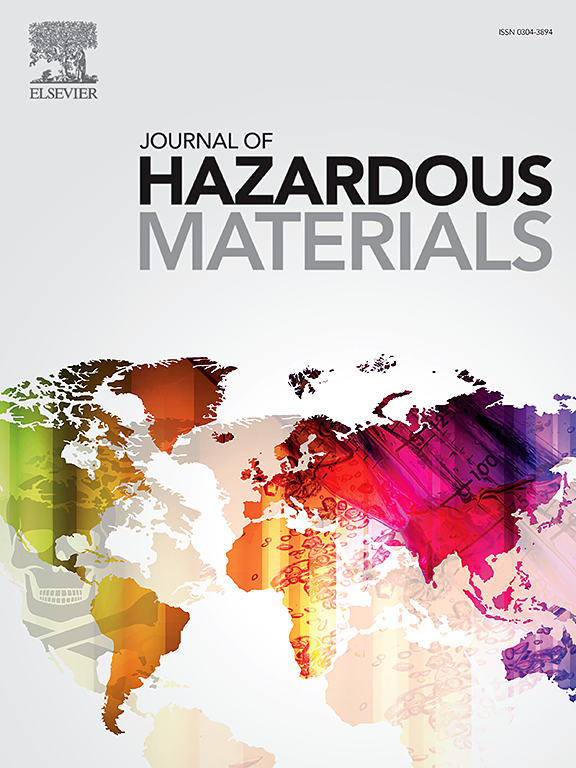Leachability of Per- and Polyfluoroalkyl Substances in Metal Recycling Streams
IF 12.2
1区 环境科学与生态学
Q1 ENGINEERING, ENVIRONMENTAL
引用次数: 0
Abstract
Automotive shredder residue (ASR), the remaining waste after vehicles and other metal recycling streams have been recycled, has been identified as a potential long-term per- and polyfluoroalkyl substance (PFAS) waste stream. However, the types, quantities, and potential leachability of PFAS in ASR are largely unknown. We quantified 33 targeted PFAS and extractable organic fluorine (EOF) in 15 ASR solid samples along with corresponding water-leachable measurements. The sum of targeted PFAS concentrations in ASR solids ranged from 9.4 to 104.2 ng/g and was dominated by long-chain perfluorinated alkyl acids (PFAAs). In contrast, short-chain PFAAs were most susceptible to leaching, resulting in aqueous targeted PFAS concentrations of 106.8 to 1015.1 ng/L. On average, 76% of perfluorooctanoic acid (PFOA) and 15% perfluorooctane sulfonate (PFOS) were water-leachable from ASR. EOF results indicated on average >99% of organic fluorine in the ASR solid samples was undetected in the targeted PFAS results, demonstrating that targeted PFAS analysis underestimates the amount of organic fluorine in ASR. Results from this study indicate that ASR can leach PFAS under some conditions, which has implications for the mobility of these chemicals in stormwater and landfill systems.

全氟烷基和多氟烷基物质在金属回收流中的浸出性
汽车碎纸机残渣(ASR),即汽车和其他金属回收流回收后的剩余废物,已被确定为潜在的长期全氟烷基物质和多氟烷基物质(PFAS)废物流。然而,在ASR中,PFAS的类型、数量和潜在的浸出性在很大程度上是未知的。我们定量了15个ASR固体样品中的33个目标PFAS和可提取有机氟(EOF),并进行了相应的水浸出测量。ASR固体中目标PFAS的浓度总和在9.4至104.2 ng/g之间,以长链全氟烷基酸(PFAAs)为主。相比之下,短链PFAAs最容易浸出,导致水中PFAS的目标浓度为106.8 ~ 1015.1 ng/L。平均76%的全氟辛酸(PFOA)和15%的全氟辛烷磺酸(PFOS)可从ASR中水浸出。EOF结果显示,靶PFAS结果平均检测不到ASR固体样品中99%的有机氟,表明靶PFAS分析低估了ASR中有机氟的含量。本研究的结果表明,在某些条件下,ASR可以浸出PFAS,这对这些化学物质在雨水和垃圾填埋场系统中的流动性有影响。
本文章由计算机程序翻译,如有差异,请以英文原文为准。
求助全文
约1分钟内获得全文
求助全文
来源期刊

Journal of Hazardous Materials
工程技术-工程:环境
CiteScore
25.40
自引率
5.90%
发文量
3059
审稿时长
58 days
期刊介绍:
The Journal of Hazardous Materials serves as a global platform for promoting cutting-edge research in the field of Environmental Science and Engineering. Our publication features a wide range of articles, including full-length research papers, review articles, and perspectives, with the aim of enhancing our understanding of the dangers and risks associated with various materials concerning public health and the environment. It is important to note that the term "environmental contaminants" refers specifically to substances that pose hazardous effects through contamination, while excluding those that do not have such impacts on the environment or human health. Moreover, we emphasize the distinction between wastes and hazardous materials in order to provide further clarity on the scope of the journal. We have a keen interest in exploring specific compounds and microbial agents that have adverse effects on the environment.
 求助内容:
求助内容: 应助结果提醒方式:
应助结果提醒方式:


